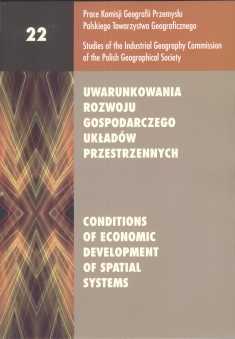Evaluation of Changes in the Branch and Educational Structure of the Labour Force in the Czech Republic with an Emphasis on Manufacturing and Services
DOI:
https://doi.org/10.24917/20801653.22.10Keywords:
labour force, branch structure, educational structure, transformation, Czech RepublicAbstract
This paper deals with the evaluation of changes in the labour force in the Czech Republic after 1989 and focuses on the branch and educational structure. The changes are also compared with processes in other countries of Central Europe. In the late 1980s the employment rate by sectors of the economy was different in Central European countries when compared with the situation in Western countries. Even subsequent transformation did not change the high share of industry and construction in total employment in the Czech Republic and Slovakia or a lower share of services. Within the manufacturing industry two stages can be distinguished. In the nineties, the majority of branches experienced a decrease in employment, whereas in the first decade of the 21st century stagnation or even reindustrialization occurred, especially when the branches associated with the automotive industry grew (other branches continued to decline). At the regional level, a diversification process was taking place all the time, if you like the transition from the specialization to the diversification. The importance of education is constantly increasing and the number of people with secondary education with GCE and tertiary education is growing. The relationship between the unemployment rate in districts of the Czech Republic and the share of employed people with tertiary education intensifies. The tertiary sector shows the highest level of education (in some branches of services more than onethird of employed has a tertiary education).
Downloads
References
Barta, G. (2005). The Role of Foreign Direct Investment in the Spatial Restructuring of Hungarian Industry. In: G. Barta, É.G. Fekete, I. Kukorelli Szörényiné, J. Timár (eds.). Hungarian Spaces and Places: Patterns of Transition, Pécs: Centre for Regional Studies, 143–160.
Barta, G., Czirfusz, M., Kukely, G. (2008). Re-industrialisation in the World and in Hungary. European Spatial Research and Policy, 15 (2), 5–26.
Domański, B. (2011). Foreign Capital and the Development of Polish Regions. Czasopismo Geograficzne, 82 (1–2), 173–187.
Fišer, P., Toušek, V., Janota, M. (2008). Changes in Employment Structure in the Czech Republic Influenced by the Transformation of Economy. In: D. Ilnicki, K. Janc, (eds.), Przekształcenia regionalnych struktur funkcjonalno-przestrzennych: Europa bez granic – nowe wyzwania. Wroclaw: University of Wroclaw, 107–114.
Gierańczyk, W., Rachwał, T. (2012). Structural Changes in the Industry of Poland against the Background of Eastern European Union States. Quaestiones Geographicae, 31 (2), 83–93.
Kulla, M. (2005). Transformácia priemyslu Bratislavy po roku 1989, dissertation, Bratislava: Komenský University in Bratislava.
Kunc, J. (2005). Transformace českého průmyslu po roce 1989 – vliv přímých zahraničních investic: regionálně geografická analýza s důrazem na Jihomoravský kraj a kraj Vysočina, dissertation. Brno: Masaryk University.
Pavlínek, P. (2004). Regional Development Implications of Foreign Direct Investment in Central Europe. European Urban and Regional Studies, 11 (1), 47–70.
Popjaková, D. (2008). Globálna verzus postsocialistická transformácia priemyslu (na príklade Slovenska), Acta geographica Universitatis Comenianae, 51, 3–25.
Stryjakiewicz, T. (2009). The Old and the New in the Geographical Pattern of the Polish Transition. Acta Universitatis Palackianae Olomucensis. Facultas Rerum Naturalium – Geographica, 40 (1), 5–24.
Šerý, O. (2012). Zaměstnanost v České republice: hodnocení změn odvětvové a vzdělanostní struktury (s využitím předběžných výsledků sčítání lidu 2011), rigorous thesis. Brno: Masaryk University.
Toušek, V., Tonev, P., (2002). Typologie okresů České republiky (podle struktury zaměstnaných s důrazem na odvětví zpracovatelského průmyslu). In: Balej, M. (ed.), XX. jubilejní sjezd ČGS „Evropská integrace – česká společnost a krajina“. Sborník tematického okruhu REG Regionální rozvoj / regionalizace. Ústí nad Labem: Univerzita J.E. Purkyně, 67–77.
Vančura, M. (2006). Vliv přímých zahraničních investic na rozvoj regionů v České republice. In: Klímová, V. (ed.), Sborník referátů z IX. mezinárodního kolokvia o regionálních vědách. Brno: Masarykova univerzita, Ekonomicko-správní fakulta, Katedra regionální ekonomie a správy, 233–239.
Ženka, J. (2008). Riziko delokalizace zpracovatelského průmyslu Česka: regionální aspekty. Geografie (Sborník ČGS), 113 (1), 1–19.
Ženka, J. (2009). Delokalizace zpracovatelského průmyslu ČR (komponentní analýza), Politická ekonomie, 57 (1), 79–93.
CZSO (Czech Statistical Office) (1990). Pracovníci a mzdové fondy socialistického sektoru národního hospodářství v krajích a okresech podle odvětví národního hospodářství v ČSR za rok 1989. 1. vyd., ČSÚ, Praha, 193 pp.
CZSO (Czech Statistical Office) (2003). Census as of 1st March 2001– inhabitants, flats, houses and households. ČZSO, Praha (all districts of the Czech Republic) CZSO (Czech Statistical Office) (2012). Preliminary results of Census 2011 – population by economic activity and branch of economic activity + population by branch of economic activity and educational attainment [database]
EUROSTAT (2012). Employment and unemployment (Labour Force Survey). [online], Eurostat, Luxembourg, (http://epp.eurostat.ec.europa.eu/portal/page/portal/ statistics/search_database) (accessed 01.09.2012).
MoLSA (Ministry of Labour and Social Affairs of the Czech Republic) (2001–2011). Integrated portal MoLSA – Employment, Unemployment Statisticts (http://portal.mpsv.cz/ sz/stat/nz/mes) (accessed 29.08.2012).
Downloads
Published
How to Cite
Issue
Section
License
Articles are published under the terms of the Creative Commons License (CC BY-ND 4.0; Attribution– NoDerivs).

